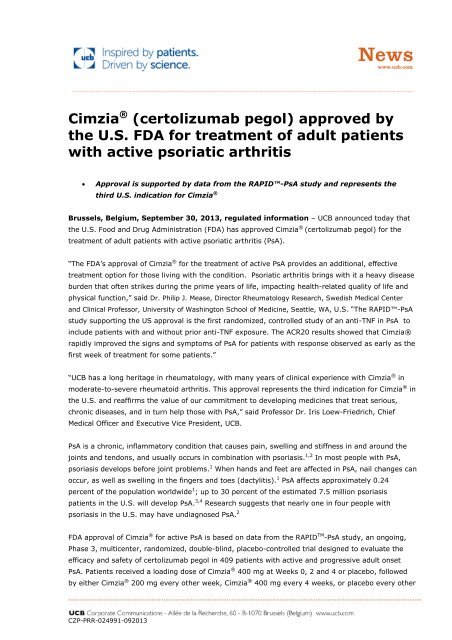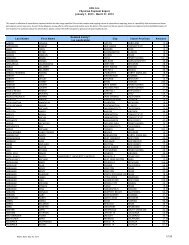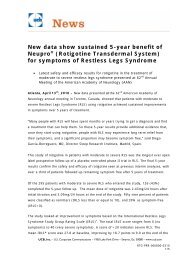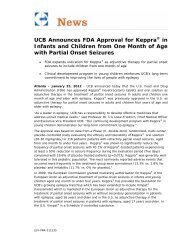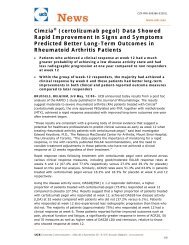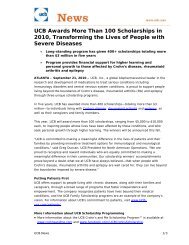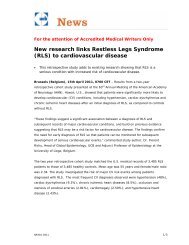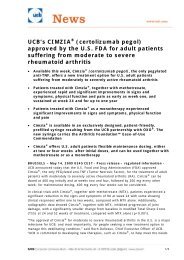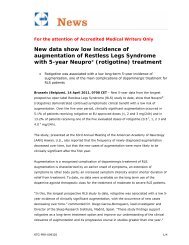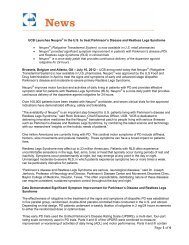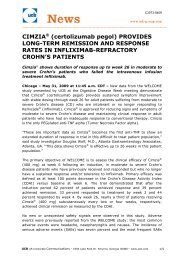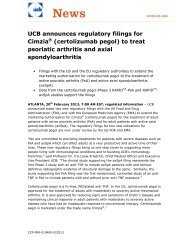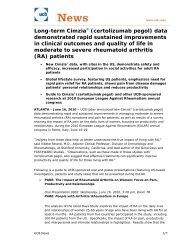Cimzia® (certolizumab pegol) approved by the U.S. FDA for ... - UCB
Cimzia® (certolizumab pegol) approved by the U.S. FDA for ... - UCB
Cimzia® (certolizumab pegol) approved by the U.S. FDA for ... - UCB
Create successful ePaper yourself
Turn your PDF publications into a flip-book with our unique Google optimized e-Paper software.
Cimzia ® (<strong>certolizumab</strong> <strong>pegol</strong>) <strong>approved</strong> <strong>by</strong><br />
<strong>the</strong> U.S. <strong>FDA</strong> <strong>for</strong> treatment of adult patients<br />
with active psoriatic arthritis<br />
<br />
Approval is supported <strong>by</strong> data from <strong>the</strong> RAPID-PsA study and represents <strong>the</strong><br />
third U.S. indication <strong>for</strong> Cimzia ®<br />
Brussels, Belgium, September 30, 2013, regulated in<strong>for</strong>mation – <strong>UCB</strong> announced today that<br />
<strong>the</strong> U.S. Food and Drug Administration (<strong>FDA</strong>) has <strong>approved</strong> Cimzia ® (<strong>certolizumab</strong> <strong>pegol</strong>) <strong>for</strong> <strong>the</strong><br />
treatment of adult patients with active psoriatic arthritis (PsA).<br />
“The <strong>FDA</strong>’s approval of Cimzia ® <strong>for</strong> <strong>the</strong> treatment of active PsA provides an additional, effective<br />
treatment option <strong>for</strong> those living with <strong>the</strong> condition. Psoriatic arthritis brings with it a heavy disease<br />
burden that often strikes during <strong>the</strong> prime years of life, impacting health-related quality of life and<br />
physical function,” said Dr. Philip J. Mease, Director Rheumatology Research, Swedish Medical Center<br />
and Clinical Professor, University of Washington School of Medicine, Seattle, WA, U.S. “The RAPID-PsA<br />
study supporting <strong>the</strong> US approval is <strong>the</strong> first randomized, controlled study of an anti-TNF in PsA to<br />
include patients with and without prior anti-TNF exposure. The ACR20 results showed that Cimzia®<br />
rapidly improved <strong>the</strong> signs and symptoms of PsA <strong>for</strong> patients with response observed as early as <strong>the</strong><br />
first week of treatment <strong>for</strong> some patients.”<br />
“<strong>UCB</strong> has a long heritage in rheumatology, with many years of clinical experience with Cimzia ® in<br />
moderate-to-severe rheumatoid arthritis. This approval represents <strong>the</strong> third indication <strong>for</strong> Cimzia ® in<br />
<strong>the</strong> U.S. and reaffirms <strong>the</strong> value of our commitment to developing medicines that treat serious,<br />
chronic diseases, and in turn help those with PsA,” said Professor Dr. Iris Loew-Friedrich, Chief<br />
Medical Officer and Executive Vice President, <strong>UCB</strong>.<br />
PsA is a chronic, inflammatory condition that causes pain, swelling and stiffness in and around <strong>the</strong><br />
joints and tendons, and usually occurs in combination with psoriasis. 1,2 In most people with PsA,<br />
psoriasis develops be<strong>for</strong>e joint problems. 1 When hands and feet are affected in PsA, nail changes can<br />
occur, as well as swelling in <strong>the</strong> fingers and toes (dactylitis). 1 PsA affects approximately 0.24<br />
percent of <strong>the</strong> population worldwide 1 ; up to 30 percent of <strong>the</strong> estimated 7.5 million psoriasis<br />
patients in <strong>the</strong> U.S. will develop PsA. 3,4 Research suggests that nearly one in four people with<br />
psoriasis in <strong>the</strong> U.S. may have undiagnosed PsA. 2<br />
<strong>FDA</strong> approval of Cimzia ® <strong>for</strong> active PsA is based on data from <strong>the</strong> RAPID TM -PsA study, an ongoing,<br />
Phase 3, multicenter, randomized, double-blind, placebo-controlled trial designed to evaluate <strong>the</strong><br />
efficacy and safety of <strong>certolizumab</strong> <strong>pegol</strong> in 409 patients with active and progressive adult onset<br />
PsA. Patients received a loading dose of Cimzia ® 400 mg at Weeks 0, 2 and 4 or placebo, followed<br />
<strong>by</strong> ei<strong>the</strong>r Cimzia ® 200 mg every o<strong>the</strong>r week, Cimzia ® 400 mg every 4 weeks, or placebo every o<strong>the</strong>r<br />
CZP-PRR-024991-092013
week. Patients were evaluated <strong>for</strong> signs and symptoms of PsA using <strong>the</strong> ACR20 response at week<br />
12 and <strong>for</strong> structural damage using <strong>the</strong> modified Total Sharp Score (mTSS) at Week 24. 5<br />
ACR20, 50, and 70 response rates at weeks 12 and 24 were higher <strong>for</strong> each Cimzia ® dose group<br />
relative to placebo. Patients treated with Cimzia ® 200 mg every o<strong>the</strong>r week demonstrated greater<br />
reduction in radiographic progression compared with placebo-treated patients at Week 24, as<br />
measured <strong>by</strong> change from baseline in total modified mTSS Score. Patients treated with Cimzia ® 400<br />
mg every four weeks did not demonstrate greater inhibition of radiographic progression at Week 24,<br />
compared with placebo-treated patients. Treatment with Cimzia ® also resulted in improvement in<br />
skin manifestations in patients with PsA. However, <strong>the</strong> safety and efficacy of Cimzia ® in <strong>the</strong><br />
treatment of patients with plaque psoriasis has not been established. 6<br />
Adverse events occurred in 62% of patients in <strong>the</strong> <strong>certolizumab</strong> <strong>pegol</strong> group (combined dose)<br />
compared to 68% of patients in <strong>the</strong> placebo group. Serious adverse events occurred in 7% of<br />
patients in <strong>the</strong> <strong>certolizumab</strong> <strong>pegol</strong> group (combined dose) compared to 4% of patients in <strong>the</strong><br />
placebo group. 7 The safety profile <strong>for</strong> patients with PsA treated with Cimzia ® was similar to <strong>the</strong><br />
safety profile seen in patients with RA and in patients with previous experience with Cimzia ® . 6 Please<br />
see important safety in<strong>for</strong>mation at <strong>the</strong> end of this press release <strong>for</strong> additional details about adverse<br />
events associated with Cimzia ® .<br />
In <strong>the</strong> U.S., Cimzia ® is also <strong>approved</strong> <strong>for</strong> <strong>the</strong> treatment of adults with moderately to severely active<br />
rheumatoid arthritis. In addition, it is <strong>approved</strong> <strong>for</strong> reducing signs and symptoms of Crohn's disease<br />
and maintaining clinical response in adult patients with moderately to severely active disease who<br />
have had an inadequate response to conventional <strong>the</strong>rapy. 7 The <strong>FDA</strong> is also reviewing a filing <strong>for</strong><br />
Cimzia ® in <strong>the</strong> treatment of adults with active axial spondyloarthritis (axSpA), including patients<br />
with ankylosing spondylitis (AS).<br />
In <strong>the</strong> EU, Cimzia ® in combination with methotrexate (MTX) is <strong>approved</strong> <strong>for</strong> <strong>the</strong> treatment of<br />
moderate to severe active rheumatoid arthritis in adult patients inadequately responsive to diseasemodifying<br />
anti-rheumatic drugs including MTX. Cimzia ® can be given as mono<strong>the</strong>rapy in case of<br />
intolerance to MTX or when continued treatment with MTX is inappropriate. 8<br />
The European Medicines Agency is currently reviewing a filing <strong>for</strong> <strong>certolizumab</strong> <strong>pegol</strong> in <strong>the</strong><br />
treatment of adult patients with active PsA. In September 2013, <strong>the</strong> European Medicines Agency’s<br />
Committee <strong>for</strong> Medicinal Products <strong>for</strong> Human Use adopted a positive opinion recommending<br />
extending <strong>the</strong> European Union marketing authorization <strong>for</strong> <strong>the</strong> use of Cimzia ® in <strong>the</strong> treatment of<br />
adult patients with severe active axSpA. A final decision from <strong>the</strong> European Commission is expected<br />
within two months.<br />
IMPORTANT SAFETY INFORMATION ABOUT CIMZIA ® IN THE US<br />
Risk of Serious Infections and Malignancy<br />
Patients treated with CIMZIA ® are at an increased risk <strong>for</strong> developing serious<br />
infections that may lead to hospitalization or death. Most patients who<br />
developed <strong>the</strong>se infections were taking concomitant immunosuppressants such<br />
<strong>UCB</strong> News<br />
CZP-PRR-024991-092013<br />
2/9
as methotrexate or corticosteroids. CIMZIA ® should be discontinued if a patient<br />
develops a serious infection or sepsis. Reported infections include:<br />
<br />
<br />
<br />
Active tuberculosis, including reactivation of latent tuberculosis. Patients<br />
with tuberculosis have frequently presented with disseminated or<br />
extrapulmonary disease. Patients should be tested <strong>for</strong> latent tuberculosis<br />
be<strong>for</strong>e CIMZIA ® use and during <strong>the</strong>rapy. Treatment <strong>for</strong> latent infection<br />
should be initiated prior to CIMZIA ® use.<br />
Invasive fungal infections, including histoplasmosis , coccidioidomycosis,<br />
candidiasis, aspergillosis, blastomycosis, and pneumocystosis. Patients<br />
with histoplasmosis or o<strong>the</strong>r invasive fungal infections may present with<br />
disseminated, ra<strong>the</strong>r than localized disease. Antigen and antibody testing<br />
<strong>for</strong> histoplasmosis may be negative in some patients with active infection.<br />
Empiric anti-fungal <strong>the</strong>rapy should be considered in patients at risk <strong>for</strong><br />
invasive fungal infections who develop severe systemic illness.<br />
Bacterial, viral and o<strong>the</strong>r infections due to opportunistic pathogens,<br />
including Legionella and Listeria.<br />
The risks and benefits of treatment with CIMZIA ® should be carefully considered<br />
prior to initiating <strong>the</strong>rapy in patients with chronic or recurrent infection.<br />
Patients should be closely monitored <strong>for</strong> <strong>the</strong> development of signs and symptoms<br />
of infection during and after treatment with CIMZIA ® , including <strong>the</strong> possible<br />
development of tuberculosis in patients who tested negative <strong>for</strong> latent<br />
tuberculosis infection prior to initiating <strong>the</strong>rapy.<br />
Lymphoma and o<strong>the</strong>r malignancies, some fatal, have been reported in children<br />
and adolescent patients treated with TNF blockers, of which CIMZIA ® is a<br />
member. CIMZIA ® is not indicated <strong>for</strong> use in pediatric patients.<br />
Patients treated with CIMZIA ® are at an increased risk <strong>for</strong> developing serious<br />
infections involving various organ systems and sites that may lead to<br />
hospitalization or death. Opportunistic infections due to bacterial,<br />
mycobacterial, invasive fungal, viral, parasitic, or o<strong>the</strong>r opportunistic pathogens<br />
including aspergillosis, blastomycosis, candidiasis, coccidioidomycosis,<br />
histoplasmosis, legionellosis, listeriosis, pneumocystosis and tuberculosis have<br />
been reported with TNF blockers. Patients have frequently presented with<br />
disseminated ra<strong>the</strong>r than localized disease.<br />
Treatment with CIMZIA ® should not be initiated in patients with an active infection,<br />
including clinically important localized infections. CIMZIA ® should be discontinued if a<br />
patient develops a serious infection or sepsis. Patients greater than 65 years of age,<br />
patients with co-morbid conditions, and/or patients taking concomitant<br />
immunosuppressants (e.g. corticosteroids or methotrexate) may be at a greater risk of<br />
infection. Patients who develop a new infection during treatment with CIMZIA ® should be<br />
closely monitored, undergo a prompt and complete diagnostic workup appropriate <strong>for</strong><br />
immunocompromised patients, and appropriate antimicrobial <strong>the</strong>rapy should be initiated.<br />
Appropriate empiric antifungal <strong>the</strong>rapy should also be considered while a diagnostic<br />
<strong>UCB</strong> News<br />
CZP-PRR-024991-092013<br />
3/9
workup is per<strong>for</strong>med <strong>for</strong> patients who develop a serious systemic illness and reside or<br />
travel in regions where mycoses are endemic.<br />
Malignancies<br />
During controlled and open-labeled portions of CIMZIA ® studies of Crohn’s disease and<br />
o<strong>the</strong>r diseases , malignancies (excluding non-melanoma skin cancer) were observed at a<br />
rate of 0.5 per 100 patient-years among 4,650 CIMZIA-treated patients versus a rate of<br />
0.6 per 100 patient-years among 1,319 placebo-treated patients. In studies of CIMZIA ®<br />
<strong>for</strong> Crohn’s disease and o<strong>the</strong>r investigational uses, <strong>the</strong>re was one case of lymphoma<br />
among 2,657 CIMZIA ® -treated patients and one case of Hodgkin lymphoma among 1,319<br />
placebo-treated patients. In CIMZIA ® RA clinical trials (placebo-controlled and open label)<br />
a total of three cases of lymphoma were observed among 2,367 patients. This is<br />
approximately 2-fold higher than expected in <strong>the</strong> general population. Patients with RA,<br />
particularly those with highly active disease, are at a higher risk <strong>for</strong> <strong>the</strong> development of<br />
lymphoma. The potential role of TNF blocker <strong>the</strong>rapy in <strong>the</strong> development of malignancies<br />
is not known.<br />
Malignancies, some fatal, have been reported among children, adolescents, and young<br />
adults who received treatment with TNF-blocking agents (initiation of <strong>the</strong>rapy ≤18 years<br />
of age), of which CIMZIA ® is a member. Approximately half of <strong>the</strong> cases were lymphoma<br />
(including Hodgkin’s and non-Hodgkin’s lymphoma, while <strong>the</strong> o<strong>the</strong>r cases represented a<br />
variety of different malignancies and included rare malignancies associated with<br />
immunosuppression and malignancies not usually observed in children and adolescents.<br />
Most of <strong>the</strong> patients were receiving concomitant immunosuppressants.<br />
Cases of acute and chronic leukemia have been reported with TNF-blocker use. Even in<br />
<strong>the</strong> absence of TNF-blocker <strong>the</strong>rapy, patients with RA may be at a higher risk<br />
(approximately 2-fold) than <strong>the</strong> general population <strong>for</strong> developing leukemia.<br />
Periodic skin examinations are recommended <strong>for</strong> all patients, particularly those with risk<br />
factors <strong>for</strong> skin cancer.<br />
Heart Failure<br />
Cases of worsening congestive heart failure (CHF) and new onset CHF have been reported<br />
with TNF blockers. CIMZIA ® has not been <strong>for</strong>mally studied in patients with CHF. Exercise<br />
caution when using CIMZIA ® in patients who have heart failure and monitor <strong>the</strong>m<br />
carefully.<br />
Hypersensitivity<br />
Symptoms compatible with hypersensitivity reactions, including angioedema, dyspnea,<br />
hypotension, rash, serum sickness, and urticaria, have been reported rarely following<br />
CIMZIA ® administration. If such reactions occur, discontinue fur<strong>the</strong>r administration of<br />
CIMZIA ® and institute appropriate <strong>the</strong>rapy.<br />
Hepatitis B Reactivation<br />
Use of TNF blockers, including CIMZIA ® , has been associated with reactivation of hepatitis<br />
B virus (HBV) in patients who are chronic carriers of this virus. Some cases have been<br />
fatal. Test patients <strong>for</strong> HBV infection be<strong>for</strong>e initiating treatment with CIMZIA ® . Exercise<br />
caution in prescribing CIMZIA ® <strong>for</strong> patients identified as carriers of HBV, with careful<br />
<strong>UCB</strong> News<br />
CZP-PRR-024991-092013<br />
4/9
evaluation and monitoring prior to and during treatment. In patients who develop HBV<br />
reactivation, discontinue CIMZIA ® and initiate effective anti-viral <strong>the</strong>rapy with appropriate<br />
supportive treatment.<br />
Neurologic Reactions<br />
Use of TNF blockers, including CIMZIA ® , has been associated with rare cases of new onset<br />
or exacerbation of clinical symptoms and/or radiographic evidence of central nervous<br />
system demyelinating disease, including multiple sclerosis, and with peripheral<br />
demyelinating disease, including Guillain-Barre syndrome. Rare cases of neurological<br />
disorders, including seizure disorder, optic neuritis, and peripheral neuropathy have been<br />
reported in patients treated with CIMZIA ® . Exercise caution in considering <strong>the</strong> use of<br />
CIMZIA ® in patients with <strong>the</strong>se disorders.<br />
Hematologic Reactions<br />
Rare reports of pancytopenia, including aplastic anemia, have been reported with TNF<br />
blockers. Medically significant cytopenia (e.g., leukopenia, pancytopenia,<br />
thrombocytopenia) has been infrequently reported with CIMZIA ® . Advise all patients to<br />
seek immediate medical attention if <strong>the</strong>y develop signs and symptoms suggestive of blood<br />
dyscrasias or infection (e.g., persistent fever, bruising, bleeding, pallor) while on CIMZIA ® .<br />
Consider discontinuation of CIMZIA ® <strong>the</strong>rapy in patients with confirmed significant<br />
hematologic abnormalities.<br />
Drug Interactions<br />
An increased risk of serious infections has been seen in clinical trials of o<strong>the</strong>r TNF blocking<br />
agents used in combination with anakinra or abatacept. Formal drug interaction studies<br />
have not been per<strong>for</strong>med with rituximab or natalizumab; however because of <strong>the</strong> nature<br />
of <strong>the</strong> adverse events seen with <strong>the</strong>se combinations with TNF blocker <strong>the</strong>rapy, similar<br />
toxicities may also result from <strong>the</strong> use of CIMZIA ® in <strong>the</strong>se combinations. There<strong>for</strong>e, <strong>the</strong><br />
combination of CIMZIA ® with anakinra, abatacept, rituximab, or natalizumab is not<br />
recommended. Interference with certain coagulation assays has been detected in patients<br />
treated with CIMZIA ® . There is no evidence that CIMZIA ® <strong>the</strong>rapy has an effect on in vivo<br />
coagulation. CIMZIA ® may cause erroneously elevated aPTT assay results in patients<br />
without coagulation abnormalities.<br />
Autoimmunity<br />
Treatment with CIMZIA ® may result in <strong>the</strong> <strong>for</strong>mation of autoantibodies and, rarely, in <strong>the</strong><br />
development of a lupus-like syndrome. Discontinue treatment if symptoms of lupus-like<br />
syndrome develop.<br />
Immunizations<br />
Do not administer live vaccines or live-attenuated vaccines concurrently with CIMZIA ® .<br />
Adverse Reactions<br />
In controlled Crohn’s clinical trials, <strong>the</strong> most common adverse events that occurred in<br />
≥5% of CIMZIA ® patients (n=620) and more frequently than with placebo (n=614) were<br />
upper respiratory infection (20% CIMZIA ® , 13% placebo), urinary tract infection (7%<br />
CIMZIA ® , 6% placebo), and arthralgia (6% CIMZIA ® , 4% placebo). The proportion of<br />
patients who discontinued treatment due to adverse reactions in <strong>the</strong> controlled clinical<br />
studies was 8% <strong>for</strong> CIMZIA ® and 7% <strong>for</strong> placebo.<br />
<strong>UCB</strong> News<br />
CZP-PRR-024991-092013<br />
5/9
In controlled RA clinical trials, <strong>the</strong> most common adverse events that occurred in ≥ 3% of<br />
patients taking CIMZIA ® 200 mg every o<strong>the</strong>r week with concomitant methotrexate<br />
(n=640) and more frequently than with placebo with concomitant methotrexate (n=324)<br />
were upper respiratory tract infection (6% CIMZIA ® , 2% placebo), headache (5%<br />
CIMZIA ® , 4% placebo), hypertension (5% CIMZIA ® , 2% placebo), nasopharyngitis (5%<br />
CIMZIA ® , 1% placebo), back pain (4% CIMZIA ® , 1% placebo), pyrexia (3% CIMZIA ® , 2%<br />
placebo), pharyngitis (3% CIMZIA ® , 1% placebo), rash (3% CIMZIA ® , 1% placebo), acute<br />
bronchitis (3% CIMZIA ® ,1% placebo), fatigue (3% CIMZIA ® , 2% placebo). Hypertensive<br />
adverse reactions were observed more frequently in patients receiving CIMZIA ® than in<br />
controls. These adverse reactions occurred more frequently among patients with a<br />
baseline history of hypertension and among patients receiving concomitant corticosteroids<br />
and non-steroidal anti-inflammatory drugs. Patients receiving CIMZIA ® 400mg as<br />
mono<strong>the</strong>rapy every 4 weeks in RA controlled clinical trials had similar adverse reactions to<br />
those patients receiving CIMZIA ® 200mg every o<strong>the</strong>r week. The proportion of patients<br />
who discontinued treatment due to adverse reactions in <strong>the</strong> controlled clinical studies was<br />
5% <strong>for</strong> CIMZIA ® and 2.5% <strong>for</strong> placebo.<br />
The safety profile <strong>for</strong> patients with PsA treated with CIMZIA ® was similar to <strong>the</strong> safety<br />
profile seen in patients with RA and previous experience with CIMZIA ® .<br />
For full prescribing in<strong>for</strong>mation, please go to www.ucb.com.<br />
http://www.cimzia.com/pdf/Prescribing_In<strong>for</strong>mation.pdf<br />
Cimzia ® (<strong>certolizumab</strong> <strong>pegol</strong>) EU/EEA* Important Safety In<strong>for</strong>mation<br />
Cimzia ® was studied in 4,049 patients with RA in controlled and open label trials <strong>for</strong> up to<br />
92 months. The commonly reported adverse reactions (1-10%) in clinical trials with<br />
Cimzia ® and post-marketing were viral infections (includes herpes, papillomavirus,<br />
influenza), bacterial infections (including abscess), rash, headache (including migraine),<br />
asthaenia, leukopaenia (including lymphopaenia, neutropaenia), eosinophilic disorder, pain<br />
(any sites), pyrexia, sensory abnormalities, hypertension, pruritus (any sites), hepatitis<br />
(including hepatic enzyme increase), injection site reactions, and nausea. Serious adverse<br />
reactions include sepsis, opportunistic infections, tuberculosis, herpes zoster, lymphoma,<br />
leukaemia, solid organ tumours, angioneurotic oedema, cardiomyopathies (includes heart<br />
failure), ischemic coronary artery disorders, pancytopaenia, hypercoagulation (including<br />
thrombophlebitis, pulmonary embolism), cerebrovascular accident, vasculitis,<br />
hepatitis/hepatopathy (includes cirrhosis), and renal impairment/nephropathy (includes<br />
nephritis). In RA controlled clinical trials, 4.4% of patients discontinued taking Cimzia ®<br />
due to adverse events vs. 2.7% <strong>for</strong> placebo.<br />
Cimzia ® is contraindicated in patients with hypersensitivity to <strong>the</strong> active substance or any<br />
of <strong>the</strong> excipients, active tuberculosis or o<strong>the</strong>r severe infections such as sepsis or<br />
opportunistic infections or moderate to severe heart failure.<br />
Serious infections including sepsis, tuberculosis and opportunistic infections have been<br />
reported in patients receiving Cimzia ® . Some of <strong>the</strong>se events have been fatal. Monitor<br />
patients closely <strong>for</strong> signs and symptoms of infections including tuberculosis be<strong>for</strong>e, during<br />
and after treatment with Cimzia ® . Treatment with Cimzia ® must not be initiated in<br />
patients with a clinically important active infection. If an infection develops, monitor<br />
carefully and stop Cimzia ® if infection becomes serious. Be<strong>for</strong>e initiation of <strong>the</strong>rapy with<br />
Cimzia ® , all patients must be evaluated <strong>for</strong> both active and inactive (latent) tuberculosis<br />
infection. If active tuberculosis is diagnosed prior to or during treatment, Cimzia ® <strong>the</strong>rapy<br />
<strong>UCB</strong> News<br />
CZP-PRR-024991-092013<br />
6/9
must not be initiated and must be discontinued. If latent tuberculosis is diagnosed,<br />
appropriate anti-tuberculosis <strong>the</strong>rapy must be started be<strong>for</strong>e initiating treatment with<br />
Cimzia ® . Patients should be instructed to seek medical advice if signs/symptoms (e.g.<br />
persistent cough, wasting/weight loss, low grade fever, listlessness) suggestive of<br />
tuberculosis occur during or after <strong>the</strong>rapy with Cimzia ® .<br />
Reactivation of hepatitis B has occurred in patients receiving a TNF-antagonist including<br />
Cimzia ® who are chronic carriers of <strong>the</strong> virus (i.e. surface antigen positive). Some cases<br />
have had a fatal outcome. Patients should be tested <strong>for</strong> HBV infection be<strong>for</strong>e initiating<br />
treatment with Cimzia ® . Carriers of HBV who require treatment with Cimzia ® should be<br />
closely monitored and in <strong>the</strong> case of HBV reactivation Cimzia ® should be stopped and<br />
effective anti-viral <strong>the</strong>rapy with appropriate supportive treatment should be initiated.<br />
TNF antagonists including Cimzia ® may increase <strong>the</strong> risk of new onset or exacerbation of<br />
clinical symptoms and/or radiographic evidence of demyelinating disease; of <strong>for</strong>mation of<br />
autoantibodies and uncommonly of <strong>the</strong> development of a lupus-like syndrome; of severe<br />
hypersensitivity reactions. If a patient develops any of <strong>the</strong>se adverse reactions, Cimzia ®<br />
should be discontinued and appropriate <strong>the</strong>rapy instituted.<br />
With <strong>the</strong> current knowledge, a possible risk <strong>for</strong> <strong>the</strong> development of lymphomas, leukaemia<br />
or o<strong>the</strong>r malignancies in patients treated with a TNF antagonist cannot be excluded. Rare<br />
cases of neurological disorders, including seizure disorder, neuritis and peripheral<br />
neuropathy, have been reported in patients treated with Cimzia ® .<br />
Adverse reactions of <strong>the</strong> hematologic system, including medically significant cytopaenia,<br />
have been infrequently reported with Cimzia ® . Advise all patients to seek immediate<br />
medical attention if <strong>the</strong>y develop signs and symptoms suggestive of blood dyscrasias or<br />
infection (e.g., persistent fever, bruising, bleeding, pallor) while on Cimzia ® . Consider<br />
discontinuation of Cimzia ® <strong>the</strong>rapy in patients with confirmed significant haematological<br />
abnormalities.<br />
The use of Cimzia ® in combination with anakinra or abatacept is not recommended due to<br />
a potential increased risk of serious infections. As no data are available, Cimzia ® should<br />
not be administered concurrently with live vaccines. The 14-day half-life of Cimzia ® should<br />
be taken into consideration if a surgical procedure is planned. A patient who requires<br />
surgery while on Cimzia ® should be closely monitored <strong>for</strong> infections.<br />
Please consult <strong>the</strong> full prescribing in<strong>for</strong>mation in relation to o<strong>the</strong>r side effects, full safety<br />
and prescribing in<strong>for</strong>mation. European SmPC date of revision 12 th August 2013.<br />
http://www.ema.europa.eu/docs/en_GB/document_library/EPAR_-<br />
_Product_In<strong>for</strong>mation/human/001037/WC500069763.pdf<br />
<strong>UCB</strong> News<br />
REFERENCES<br />
1. Psoriatic Arthritis, Genetics Home Reference. Accessed September 2013 from<br />
http://ghr.nlm.nih.gov/condition/psoriatic-arthritis<br />
2. National Psoriasis Foundation. [Facts about Psoriasis and Psoriatic Arthritis] Accessed<br />
September 2013 from<br />
http://www.psoriasis.org/document.doc?id=191<br />
3. About Psoriasis. National Psoriasis Foundation. Accessed September 2013 from<br />
https://www.psoriasis.org/about-psoriasis<br />
4. Psoriatic Arthritis. National Psoriasis Foundation. Accessed September 2013 from<br />
https://www.psoriasis.org/psoriatic-arthritis<br />
5. Mease, P., Fleischmann, R. M. et al. Effect of <strong>certolizumab</strong> <strong>pegol</strong> on signs and<br />
symptoms in patients with psoriatic arthritis: 24-week results of a Phase 3 doubleblind<br />
randomized placebo-controlled study (RAPID-PsA) Ann Rheum Dis 2013;0:1–8.<br />
CZP-PRR-024991-092013<br />
7/9
doi:10.1136/annrheumdis-2013-203696. Accessed September 2013 from<br />
http://ard.bmj.com/content/early/2013/08/28/annrheumdis-2013-203696.full.pdf<br />
6. Cimzia ® US Prescribing In<strong>for</strong>mation. Accessed September 2013 from<br />
7. http://www.cimzia.com/pdf/Prescribing_In<strong>for</strong>mation.pdf<br />
8. Mease, P., Fleischmann, R. M. et al. Effect of <strong>certolizumab</strong> <strong>pegol</strong> on signs and<br />
symptoms in patients with psoriatic arthritis with and without prior anti-TNF<br />
exposure: 24 week results of a phase 3 double-blind randomized placebo-controlled<br />
study. Arthritis Rheum. 2012;64(Suppl 10);S1107. ACR Meeting & 47th Annual<br />
meeting of <strong>the</strong> Association of Rheumatology Health Professionals (ARHP);<br />
Washington; D.C., USA<br />
9. Cimzia ® EU Summary of Product Characteristics. Accessed September 2013 from<br />
http://www.ema.europa.eu/docs/en_GB/document_library/EPAR_-<br />
_Product_In<strong>for</strong>mation/human/001037/WC500069763.pdf<br />
For fur<strong>the</strong>r in<strong>for</strong>mation<br />
Andrea Levin, Associate Director, PR & Communications<br />
T +1 770 970 8352, andrea.Levin@ucb.com<br />
Eimear O Brien, Director, Brand Communications<br />
T +32.2.559.9271, eimear.obrien@ucb.com<br />
Antje Witte, Investor Relations <strong>UCB</strong><br />
T +32.2.559.9414, antje.witte@ucb.com<br />
France Nivelle, Global Communications, <strong>UCB</strong><br />
T +32.2.559.9178, france.nivelle@ucb.com<br />
Laurent Schots, Media Relations, <strong>UCB</strong><br />
T +32.2.559.9264, laurent.schots@ucb.com<br />
About <strong>UCB</strong><br />
<strong>UCB</strong>, Brussels, Belgium (www.ucb.com) is a global biopharmaceutical company focused on <strong>the</strong><br />
discovery and development of innovative medicines and solutions to trans<strong>for</strong>m <strong>the</strong> lives of people<br />
living with severe diseases of <strong>the</strong> immune system or of <strong>the</strong> central nervous system. With more than<br />
8 500 people in about 40 countries, <strong>the</strong> company generated revenue of EUR 3.4 billion in 2012. <strong>UCB</strong><br />
is listed on Euronext Brussels (symbol: <strong>UCB</strong>).<br />
Forward looking statements<br />
This press release contains <strong>for</strong>ward-looking statements based on current plans, estimates and<br />
beliefs of management. All statements, o<strong>the</strong>r than statements of historical fact, are statements that<br />
could be deemed <strong>for</strong>ward-looking statements, including estimates of revenues, operating margins,<br />
capital expenditures, cash, o<strong>the</strong>r financial in<strong>for</strong>mation, expected legal, political, regulatory or clinical<br />
results and o<strong>the</strong>r such estimates and results. By <strong>the</strong>ir nature, such <strong>for</strong>ward-looking statements are<br />
not guarantees of future per<strong>for</strong>mance and are subject to risks, uncertainties and assumptions which<br />
could cause actual results to differ materially from those that may be implied <strong>by</strong> such <strong>for</strong>wardlooking<br />
statements contained in this press release. Important factors that could result in such<br />
differences include: changes in general economic, business and competitive conditions, <strong>the</strong> inability<br />
to obtain necessary regulatory approvals or to obtain <strong>the</strong>m on acceptable terms, costs associated<br />
with research and development, changes in <strong>the</strong> prospects <strong>for</strong> products in <strong>the</strong> pipeline or under<br />
development <strong>by</strong> <strong>UCB</strong>, effects of future judicial decisions or governmental investigations, product<br />
liability claims, challenges to patent protection <strong>for</strong> products or product candidates, changes in laws<br />
or regulations, exchange rate fluctuations, changes or uncertainties in tax laws or <strong>the</strong><br />
administration of such laws and hiring and retention of its employees. <strong>UCB</strong> is providing this<br />
in<strong>for</strong>mation as of <strong>the</strong> date of this press release and expressly disclaims any duty to update any<br />
in<strong>for</strong>mation contained in this press release, ei<strong>the</strong>r to confirm <strong>the</strong> actual results or to report a change<br />
in its expectations.<br />
<strong>UCB</strong> News<br />
CZP-PRR-024991-092013<br />
8/9
There is no guarantee that new product candidates in <strong>the</strong> pipeline will progress to product approval<br />
or that new indications <strong>for</strong> existing products will be developed and <strong>approved</strong>. Products or potential<br />
products which are <strong>the</strong> subject of partnerships, joint ventures or licensing collaborations may be<br />
subject to differences between <strong>the</strong> partners. Also, <strong>UCB</strong> or o<strong>the</strong>rs could discover safety, side effects<br />
or manufacturing problems with its products after <strong>the</strong>y are marketed.<br />
Moreover, sales may be impacted <strong>by</strong> international and domestic trends toward managed care and<br />
health care cost containment and <strong>the</strong> reimbursement policies imposed <strong>by</strong> third-party payers as well<br />
as legislation affecting biopharmaceutical pricing and reimbursement.<br />
<strong>UCB</strong> News<br />
CZP-PRR-024991-092013<br />
9/9


